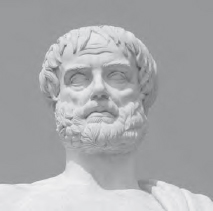Ancient PhilosophyAristotle |
What is known about Aristotle’s life? |
Aristotle of Stagira (384–322 B.C.E.), also known as The Stagirite, was the son of Nichomachus, who was the Macedonian King Amyntas II’s court physician. Aristotle’s career was shaped by this relationship with his scientific father. When Aristotle was 17, he enrolled in Plato’s Academy in Athens. After Plato died in 347 B.C.E. and the Academy’s curriculum changed toward the mathematical and speculative interests of its new head, Speusippus (407–339 B.C.E.), Aristotle left for Assos, which was then under the leadership of Hermias, a former slave who rose to the position of ruler that his master had held. Aristotle married Hermias’ niece, Pythias, in 345 B.C.E., and after Hermias died, he traveled to Lesvos.
The island of Lesvos, in the northeastern Aegean Sea, had a great diversity of marine creatures and contemporary mammals, as well as many ancient fossils. Aristotle pursued his biological research on the taxonomy of living beings there. In 343 B.C.E., King Philip of Macedonia invited Aristotle to serve as tutor to his son, Alexander, who was to become Alexander the Great. In 335 B.C.E., Aristotle returned to Athens. He founded a school, the Lyceum, in a grove dedicated to Apollo Lyceus outside of the city. At the Lyceum, Aristotle lectured and directed research. He also constructed and stocked the first great library in ancient times. The walkway under a colonnade, or “peripatos,” was the source of the name “Perapatetics” that was given to the members of the Lyceum.
After the death of his wife, Pythias, Aristotle lived with and had a son with Herphyllis. Their son was named after Aristotle’s father, Nichomachus, after whom he also named his work on ethics. When Alexander, now Alexander the Great, died in 325 B.C.E., Aristotle retired to Chalcis, where he lived for the remainder of his life.

